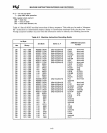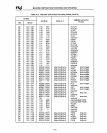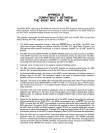
APPENDIX
B
COMPATIBILITY BETWEEN
THE
80287
NPX
AND
THE
8087
The 80286/80287 operating in Real-Address mode
will
execute 8087 programs without major modifi-
cation. However, because of differences
in
the handling of numeric exceptions by the 80287
NPX
and
the 8087 NPX, exception-handling routines
may
need to
be
changed.
This appendix summarizes the differences between the 80287
NPX
and the 8087 NPX, and provides
details showing
how
8087 programs can be ported to the 80287.
1.
The 80287 signals exceptions through a dedicated
ERROR
line to the 80286. The 80287 error
signal does not pass through an interrupt controller (the 8087
INT
signal does). Therefore, any
interrupt-controller-oriented instructions
in
numeric exception handlers for the 8087 should be
deleted.
2.
The 8087 instructions
FENI/FNENI
and
FDISI/FNDISI
perform
no
useful function
in
the 80287.
If
the 80287 encounters one of these opcodes
in
its instruction stream, the instruction
will
effec-
tively be
ignored-none
of the 80287 internal states
will
be updated. While 8087 code containing
these instructions may
be
executed
on
the 80287, it
is
unlikely that the exception-handling routines
containing these instructions will be completely portable to the 80287.
3.
Interrupt vector
16
must point to the numeric exception handling routine.
4.
The
ESC
instruction address saved in the 80287 includes any leading prefixes before the
ESC
opcode. The corresponding address saved
in
the 8087 does not include leading prefixes.
S.
In Protected-Address mode, the format of the 80287's saved instruction and address pointers
is
different than for the 8087. The instruction opcode
is
not saved
in
Protected
mode-exception
handlers will have to retrieve the opcode from memory if needed.
6.
Interrupt 7
will
occur
in
the 80286 when executing ESC instructions with either TS (task switched)
or
EM
(emulation) of the 80286
MSW
set (TS = 1 or EM =
1).
If
TS
is
set, then a WAIT instruc-
tion
will
also cause interrupt
7.
An exception handler should be included
in
80287
code
to handle
these situations.
7.
Interrupt 9 will occur if the second or subsequent words of a floating-point operand fall outside a
segment's size. Interrupt
13
will
occur if the starting address of a numeric operand falls outside a
segment's size. An exception handler should be included in 80287 code
to
report these program-
ming errors.
8.
Except for the processor control instructions, all of the 80287 numeric instructions are automati-
cally synchronized by the 80286
CPU-the
80286 automatically tests the
BUSY
line
from the
80287 to ensure that the 80287 has completed its previous instruction before executing the next
ESC
instruction. No explicit
W1AIT
instructions are required to assure this synchronization. For
the 8087 used with 8086 and 8088 processors, explicit WAITs are required before each numeric
instruction to ensure synchronization. Although 8087 programs having explicit WAIT instructions
will
execute perfectly
on
the 80287 without reassembly, these WAIT instructions are unnecessary.
9.
Since the 80287
does
not require WAIT instructions before each numeric instruction, the ASM286
assembler does not automatically generate these WAIT instructions. The ASM86 assembler,
however, automatically precedes every
ESC instruction with a WAIT instruction. Although numeric
routines generated using the ASM86 assembler
will
generally execute correctly
on
the 80286/20,
reassembly using ASM286 may result in a more compact code image.
8-1


















